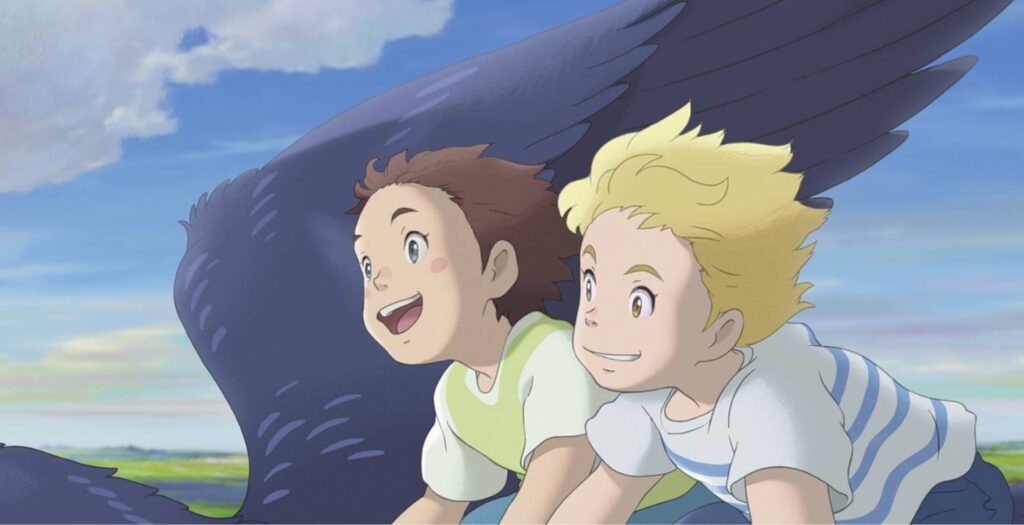The Imaginary comes from renowned director Yoshiyuki Momose, whose work on Studio Ghibli films inspired multiple generations of animation lovers. A Netflix Original film about growing up, grief, and how we protect ourselves, The Imaginary is animated by Studio Ponoc, with Yoshiaki Nishimura, Satoshi Suzuki, and Nobuyuki Iinuma serving as executive producers and two-time Academy Award nominee Nishimura serving as the film’s screenwriter. The magic that this team brought to projects like Spirited Away and The Tale of Princess Kaguya, as well as other Ghibli films, is alive in this adaptation of a novel of the same name by A.F. Harrold and illustrated by Emily Gravett.
The Imaginary follows Amanda and Rudger (Louie Rudge-Buchanan). Amanda (Evie Kiszel) and her mother, Lizzie (Hayley Atwell), find themselves with only a small, struggling bookstore, accompanied by a boy named Rudger, who lives in the attic after the loss of the family’s patriarch. The catch is that Rudger isn’t real. He is a figment of Amandaʼs imagination, visible only to Amanda and shaped by her heart. The Imaginary is a fantastical odyssey about Rudger and his friends as they embark on an unseen quest to save their family and loved ones.
The film has two foundational pieces of the story: love and loss. More importantly, how the two are braided together by hope. As much as the film is a look at the fantastical, it is a story about how Rudger and Amanda both bravely confront the fear that haunts them, manifesting externally as Mr. Bunting (Jeremy Swift), a man who eats the imaginary friends and, with it, the hope they bring. When Amanda is injured, this journey falls onto Rudger. Expected to meet the fate that all forgotten imaginary friends do, to fade into nothingness, he holds onto Amanda and her memory and sets forth on a mission to return to her.
With the help of Zimzan (Kal Penn), The Old Dog (LeVar Burton), Aurora (Ruby Barnhill), Snowflake (Roger Craig Smither), and Cruncher-of-Bones (Courtenay Taylor), Rudger pushes past expectations and refuses to let Amanda lose the hope and love he brings to her life. Each imaginary friend forms a shield, protecting Amanda from the evil encroaching on her life. At the highest level, a clear takeaway from the film is the importance of protecting children and their innocence and, more importantly, understanding how to do that when tragedy strikes.
The Imaginary asks its audience to see children as capable of processing loss in dark times.

It’s easy to protect the most vulnerable among us when the world is good, but when they lose someone and loneliness strikes, the job is infinitely harder. However, instead of resigning ourselves to ignoring the negative and hoping it’s not felt, The Imaginary tells parents and other adults that we have to talk and open the door. We have to let children guide us through their imaginations, and through them, we can find the beauty that they use to handle their fears.
In Momose’s typical animation style, the world is both whimsical and grounded in reality, and when the two meet, something special happens. The beautiful environments and landscapes (with Deho Gallery contributing work) immediately feel real, and the characters and rounded elements of life feel just on the edge of fantasy. The Imaginary speaks directly to its audience and asks us to think about who we are, who we want to become, and how our imagination protects us. It’s a film about imaginary friends, but more importantly, it’s a story about the function they fulfill in our lives. They protect us from our fears and sometimes become the versions of ourselves we aspire to be.
For Rudger and Amanda, their promise to each other is to protect each other and to never cry. While most of the story is told from Rudger’s point of view and his desperation to return to his real friend, The Imaginary doesn’t forget Amanda and her position. Her innocence and youth are pivotal to understanding the film’s narrative. Amanda has put all of her strength, sadness, pain, and joy into Rudger. He is how she copes and how she learns to survive.
The Imaginary teaches its adult audience that children aren’t immune to grief. Amanda’s story is rooted in a loss that she doesn’t quite understand how to explain. She may not have the clear words to discuss it, but she knows how it feels. It’s something her mother discovers as she looks through her room, and it becomes unequivocally clear that children deserve respect and space to both be children and explore the complexity of negative emotions as much as positive ones. When Amanda’s mother embraces this reality, she is allowed to peer into the world of the imaginary and speak to her daughter in the language she understands.
This Netflix Animation film is truly an all-ages take on grief.

The Imaginary is unbelievably salient for all ages. For the young and old, it confronts the reality of growing up and letting go. The film is a whimsical story of grief, but not in the way that you may think. While death is present, the grief that grounds the narrative is the loss of our childhood. The loss of our imaginations and, in some cases, the refusal to accept both of those things and the pain that causes.
Animation Director Ken’ichi Konishi showcases hand-drawn animation and new light and shadow techniques that remind viewers of the power of 2D art and how lighting and shadow can embrace the three-dimensionality of characters. The Imaginary is a testament to the medium’s power. More importantly, the film demonstrates the vitality of hand-drawn illustrations and the magical ways they transport viewers to new worlds. They bring to life the world through a lens that is just ever so slightly focused on the whimsy of the banal while also capturing reality through textures, light, and landscapes.
Not without its third-act pacing faults, The Imaginary’s depth of emotional exploration is a must-watch for all ages. It speaks to young viewers, their parents, and even those who don’t have kids in similar but different ways. With one central message, the film never loses sight of the fact that it’s also universal.
Beautifully animated, The Imaginary delivers emotional gut punches, fantastical joy, and deep laughs. It balances these emotions against each other and, in doing so, crafts an emotional and intimate story that is easy to fall into but, more importantly, empathize with. At halfway through the year, I think it’s safe to say that between Ultraman Rising and The Imaginary, Netflix has two award contenders.
The Imaginary is streaming exclusively on Netflix.
The Imaginary (2024)
-
Rating - 9/109/10
TL;DR
The Imaginary’s depth of emotional exploration is a must-watch for all ages. It speaks to young viewers, their parents, and even those who don’t have kids in similar but different ways. With one central message, the film never loses sight of the fact that it’s also universal.








